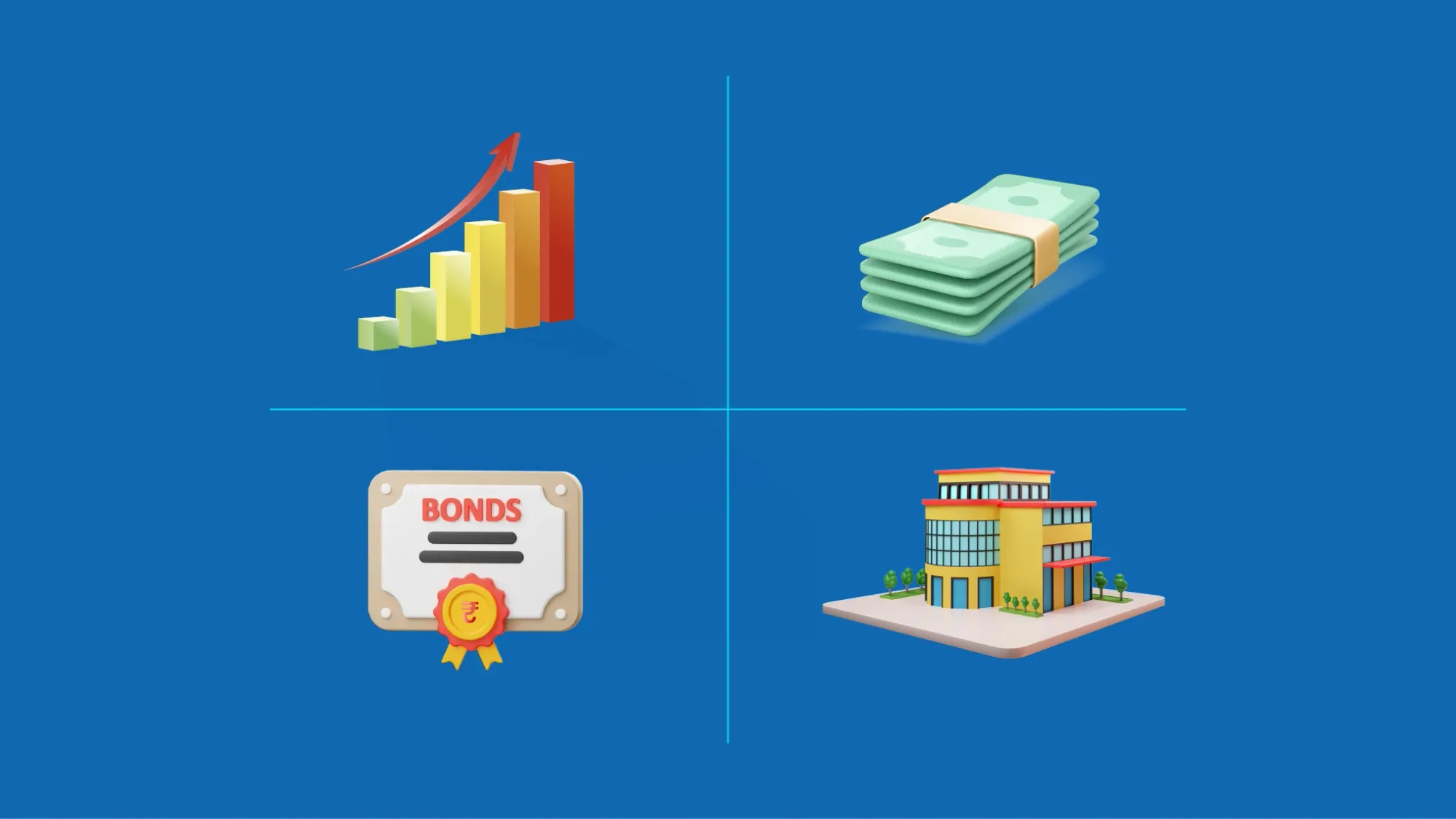Types of Asset Class

- Published Date: September 12, 2024
- Updated Date: November 28, 2025
- By Team Choice
Investors must know where their money is invested. Investment managers use one or more asset classes to generate returns. Understanding these will help you make informed decisions about your investment. The risks and rewards from your investments depend on the asset classes. Let's understand the significance of different types of asset classes in investment avenues for better portfolio optimisation.
What is Asset Class?
A group of financial instruments or securities with similar characteristics is collectively known as an asset class.
The securities within the asset class behave similarly in the market. The risk-return profile of an investment varies based on the underlying securities. Depending on your financial goals, risk tolerance, and investment horizon, you can choose to invest in one or more asset classes. For effective portfolio management, understanding these asset classes and determining the right allocation is crucial.
Asset classes for investment may be tangible or intangible. High-risk asset classes such as stocks and commodities offer higher returns. Low-risk asset classes like bonds, FDs, and others reduce risk and limit returns. An optimal investment portfolio contains high and low-risk asset classes to ensure positive returns.
Types of Asset Classes
The asset classes are categorised based on liquidity, investment structure, and market capitalisation. The common types of asset classes are explained below:
Equity
Also known as stocks, equity represents ownership in a company of your choice. Investors buy stocks of companies hoping to earn profit through dividend payments and capital appreciation as the company valuation increases in the future. Equity belongs to one of the high-risk options as the investment performance depends on variable factors. However, equity investments offer excellent rewards to investors.
Best For Long-term growth, investors comfortable with market fluctuations.
Example: Investing in large-cap Indian companies like Reliance Industries or Infosys.
Fixed Income Asset
Bonds are fixed-income debt instruments issued by corporations or governments. Investors purchase bonds to get regular interest payments and return on the investment capital. Compared to equity, investment bonds carry lower risks and lower return potential.
Best For: Conservative investors seeking stable income and capital preservation.
Example: Government bonds like the 10-year Indian government or corporate bonds from blue-chip companies.
Cash and Cash Equivalents
Money market funds, certificates of deposits, and savings accounts are highly liquid investments commonly grouped as cash and cash equivalents. These low-risk investments offer little to no potential for capital appreciation. You may park your emergency funds in these vehicles.
Best For: Short-term savings, emergency funds, low-risk investments.
Example: Saving accounts in major Indian banks or fixed deposits with competitive interest rates.
Real Estate
Investing in physical properties such as a commercial building or a residential house, and investment in real estate investment trusts and mutual funds are considered as real estate asset classes. Physical real estate investments offer a steady income stream through rental income. They also have long-term appreciation potential. However, market fluctuations and maintenance costs can hinder real estate investment.
Best For Investors looking for tangible assets with rental income and long-term appreciation.
Example: Residential properties in metropolitan areas like Mumbai or commercial spaces in growing business hubs.
Commodities
You can invest in physical goods such as oil, gold, metals, agricultural products, and other types of commodities by trading them on commodity exchanges. These offer protection against inflation and market volatility. However, the returns vary based on supply-demand fluctuations.
Best For Investors looking for diversification and protection against inflation.
Example: Gold ETFs or futures contracts on commodities like crude oil.
Alternative asset classes
Beyond traditional investment categories, new-age alternative asset classes such as private equity, hedge funds, cryptocurrency, and more are now available. These alternative investments offer attractive returns, but some of these are not linked to the market. However, the new age options carry higher risks and fees, and sometimes, the landscape is difficult to comprehend.
Best For: Experienced investors seeking high returns and willing to take on higher risk.
Example: Investments in private equity funds, cryptocurrencies like Bitcoin, or hedge funds.
Overview of The Different Types of Asset Class:
| Asset Class | Pros | Cons |
|---|---|---|
| Equity (Stocks) |
|
|
| Fixed Income Assets |
|
|
| Cash and Cash Equivalents |
|
|
| Real Estate |
|
|
| Commodities |
|
|
| Alternative Asset Classes |
|
|
Understanding Asset Allocation For Investment Strategies
The investment strategies focus on growth and value to generate income. The portfolio performance depends on the chosen asset type. Asset allocation is established in different ways, explained below:
Strategic Asset Allocation
The investor or an authorised fund manager uses a combination of asset classes to generate expected rates of returns for each asset class. They consider the investment time frame and risk-return ratio to maximise returns. Diversification is crucial for strategic asset allocation to limit risk and increase returns.
Dynamic Asset Allocation
Here, the combination of asset classes changes based on the rise or fall of the market. When the economy strengthens or weakens, asset allocation is changed to reflect the current position. Generally, this strategy encourages selling assets with declining value and purchasing assets with higher potential for increasing value. This helps ensure overall returns on the portfolio.
Integrated Asset Allocation
Apart from considering the market conditions, an integrated asset allocation strategy prioritises the economic expectations of individuals. The risk tolerance of individual investors is also considered when choosing asset classes for investments. Thus, your portfolio will be customised to fit your risk appetite.
Insured Asset Allocation
In this type of asset allocation, a benchmark value is established so that the returns from the portfolio will not go below the threshold. The fund manager uses active management to decide on asset allocation as long as the portfolio generates returns above the threshold. When the portfolio returns below the benchmark, the fund manager stabilises using risk-free assets. This added security of maintaining an assured benchmark below which the portfolio cannot decline is preferred by risk-averse investors.
Investors must choose the above-mentioned allocation based on their investment needs. However, adequate research and a thorough understanding of market movement are required. A basic understanding of asset classes and allocation will help you diversify the portfolio based on your risk tolerance.
How do Asset Classes Help With Diversification?
Diversification is essential to improve the risk management of investment portfolios. To optimise the risk of your investment, you must choose different asset classes. It will help you capitalise on the performance of varied asset classes under different market conditions.
Even though equity offers better returns, the stocks may perform poorly during a recession, and real estate may provide better returns during this time. Similarly, when the market is favourable, the returns from stocks may increase and balance out the stable returns from bonds. Diversification aims to reduce your loss through one asset class and compensate for it with increased earnings from other asset classes.
Achieving an optimal balance between risk and return through different asset classes will help you meet your investment objectives. Young investors can choose high-risk investments for an extended time horizon. Similarly, those approaching retirement age can choose to minimise their losses and go for fixed-income generation by investing in low-risk asset classes.
Conclusion
A group of investments that show similar characteristics and features and respond to market variations in a similar way to form an asset class. The different types of asset classes have varying risk-return profiles. Generally, when one asset class performs poorly, the others may perform better. That is why diversification by investing in multiple asset classes is crucial to building an optimal investment portfolio.
Looking for the best investment option? Explore the different asset classes and choose the right investment vehicle using Choice for your financial needs.
FAQ
What are The Five Major Asset Classes?
Cash, fixed-principal investments, debt, equity, and tangibles are the five types of asset classes.
Additional Factors in Classifying Assets
Liquidity: How easily an asset can be bought or sold. Cash and stocks are highly liquid; real estate and private equity are less so.
Risk: The chance of an investment losing value. Higher risk often means higher potential returns. Stocks are riskier than bonds or cash.
Volatility: How much an asset's price fluctuates. Stocks and commodities are more volatile than bonds or cash.
Investment Size: The minimum amount needed to invest. Real estate and private equity require larger investments than stocks and bonds.
Recommended for you

Covered Call Strategy Explained

FII DII Data - Live Data

Share Market Prediction For Tomorrow
